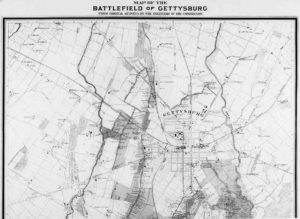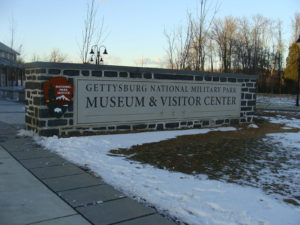Background
In 1863, a major battle of the Civil War was fought in the small town of Gettysburg,  Pennsylvania. Lasting from July 1st to 3rd, it marked the farthest north that the Confederacy was ever able to go. Ultimately the Union was victorious and the Confederacy was driven back, but only after both sides experienced heavy loss of life. This battle was and is widely considered a major turning point of the war in the Union’s favor.
Pennsylvania. Lasting from July 1st to 3rd, it marked the farthest north that the Confederacy was ever able to go. Ultimately the Union was victorious and the Confederacy was driven back, but only after both sides experienced heavy loss of life. This battle was and is widely considered a major turning point of the war in the Union’s favor.
Commemoration History
It did not take long for a fascination with Gettysburg to take root in the American psyche. A month after the battle that made the site famous, the Gettysburg Battlefield Memorial Association (GBMA) was formed in order to help “preserve the battlefield” (Weeks 42). Its cemetery was officially dedicated by President Abraham Lincoln in November 1863 (Gatewood and Cameron 194). By 1870, the Gettysburg Springs Hotel was established to cater to a more middle-class clientele (Weeks 43) and thus make Gettysburg more accessible to the general public. This goal was only aided by the opening of the Gettysburg and Harrisburg railroad in 1884 (Weeks 45), which made it access to the battlefield possible for tourists who were not wealthy enough to own a car.
“In its combination of instruction, moral elevation, and entertainment, Gettysburg represented the quintessential middle-class experience.”
–Jim Weeks, “Gettysburg: Display Window for Popular Memory”
As the number of tourists visiting the park dramatically increased, the GBMA formulated yet more plans for improving the park. Even before it was turned over to the War Department in 1894, 600 acres of land with an impressive 320 monuments had been established for the park (Weeks 45). Though most are in honor of an entire regiment, some significant war figures did receive individual commemoration.
Significance Today

Today, Gettysburg is run by the National Parks Service and consists of 3,500 acres of land (Gatewood and Cameron 194). Receiving over 1.5 million visitors each year, it now contains over 1,300 monuments, which commemorate those who fought for both the Union and the Confederacy; bus tours and reenactments occur regularly (Gatewood and Cameron 195). Another notable feature is that of the Cyclorama Building, which houses an enormous mural of Pickett’s Charge (Gatewood and Cameron 195), the tactical maneuver by the Union which decisively turned the tide of the battle towards their victory. This is only one of many existing pieces of art commemorating the American Civil War.
Connection to the Easter Rising
Gettysburg was a marked turning point for the Union winning the war, but whether or not the Union’s ultimate victory was a “success” depended upon which side one had fought for, or, in modern times, whether one lives in the North or the South. In other words, the success of the Civil War is disputed. In Northern classrooms, it is presented as the North valiantly succeeding in keeping the country in one piece while abolishing the institution of slavery. In the South, on the other hand, it is viewed more as a demolition of Southern rights–something that did not keep the country in one piece but rather ignored the rights of one half of its states and thereby divided the country even more deeply. This is markedly different from the interpretation of the Easter Rising, which is unambiguously seen an uprising that failed, no matter where in Ireland one lives. It was not half the country versus another half, divided upon ideological issues, but instead a tiny minority in Dublin rebelling against what they saw as the repressive authority of the massive British government. There is much dispute even today over what the Easter Rising means, but the outcome, unlike that of the Civil War, is never questioned.





